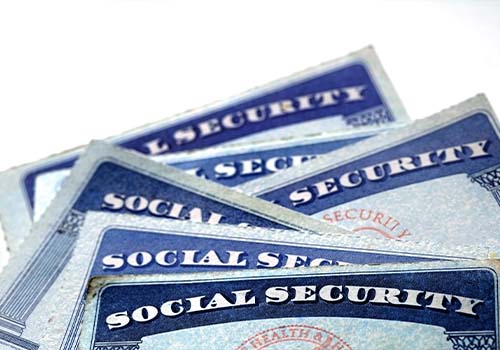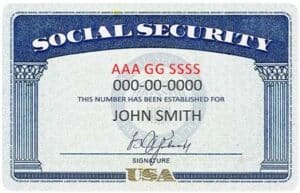Most people have their Social Security number memorized or know where to find their SSN. This number is critical for identification purposes, and you need to have it whenever you attempt to get a loan, open a bank account, or perform many other services.
Most people never really think about the structure of the Social Security number itself. You might know that it is nine digits, but do you know why the number is separated the way it is? Also, do you know the significance and meaning of each section of your SSN? If not, keep reading as we give you all the details on the formatting of Social Security numbers.
Social Security Number Format
The Social Security number format is a nine-digit number, generally separated by hyphens into sections of three, two, and four digits. For example, a typical SSN follows the format of “AAA-GG-SSSS,” where A represents the Area number, G represents the Group number, and S represents the Serial number. The format has remained relatively unchanged since the first Social Security numbers were assigned in 1936.
Contrary to popular belief, Social Security numbers are not assigned in consecutive order. The process used by the Social Security Administration (SSA) to assign SSNs has changed a couple of times over the years. Up until 1972, numbers were assigned by Social Security field offices. The field office in your geographic area would assign your SSN.
Since 1972, all numbers have been assigned by the central office of the Social Security Administration. While it is hard to obtain details about the order in which numbers are assigned, information is available about what each section of numbers means. We will discuss the significance of each group of numbers in the following sections of this article.
– Area Number (AAA)
The first section of the three digits of your SSN is the area number. Some people also call this the Social Security number prefix. This number is associated with a specific geographical location. Similar to ZIP codes with the post office, area codes for your SSN started in the Northeast and worked westward.
This means folks in the Northeast had lower numbers than those on the West Coast. Again, the process change in 1972 also affected how area numbers were assigned. After 1972, the area number was assigned based on the ZIP code of the mailing address on your Social Security card application.
Since these numbers are based on the mailing address provided on the application, the assignment is not necessarily based on the location of a person’s permanent residence. Someone might live in one state but temporarily have their mailing address in another. So, you cannot necessarily use an SSN to determine where someone lives. Plus, since most people are assigned an SSN at birth, they might move many times throughout their lives.
– Group Number (GG)
The group number is the middle section of the two digits of a valid SSN. The group number is a way of breaking the areas into smaller sections, although the group number is not associated with a specific geographic region. Instead, the group numbers are assigned in a specific order for each particular area. First, the odd numbers 01 to 09 are allocated. Next, even numbers from 10 to 98 are assigned. Then, even numbers 02 through 08 can be used, and finally, odd numbers from 11 to 99 will be assigned. The number “00” is never used for the group number.
Each month, the Social Security Administration publishes a report that shows the highest group number assigned for a specific area number. For example, suppose the report indicates that the highest group number for a particular area is 68. In that case, you know that 72 or 13 is not a valid group number for that area since the numbers are assigned in order following the rules above.
– Serial Number (SSSS)
The last group of four digits in your SSN is the serial number. Serial numbers are assigned strictly chronologically per area and group number. It is worth noting that this did not always seem to be the case before 1965 when field offices assigned numbers. Then, there appeared to be more randomization, as some groups of serial numbers seemed to be assigned out of order.
However, today, the assignment of a serial number for each area and group starts at “0001” and continues upward to “9999.” Note that “0000” is never a valid serial number. Any group of all zeros is never a valid number in any section of an SSN.
You might think you could look at a person’s SSN and determine their age. However, that is not always the case. Serial numbers are assigned based on the time an application is received, and not everyone applies for a Social Security number at birth. Issuance of an SSN for some people may occur well into adulthood, while others may be assigned a few weeks after birth.
KEY TAKEAWAYS
- Social Security numbers were established as part of the Social Security Act of 1935 and were initially only used to track earnings history.
- SSN consists of three parts: an Area Number, a Group Number, and a Serial Number. These numbers have a pattern for how they get assigned.
Social Security ‘Area Code’ Number Chart
The Social Security Administration website provides a complete listing of area codes and their associated geographic region. Remember that the area codes are not limited to the 50 United States. American citizens born in U.S. territories may also request a Social Security number, so the regions must include these locations. Below are all the Social Security area codes and the regions they are associated with.
You might notice that some area numbers are included in more than one region. This means that the number was transferred from one region to another or used in more than one area.
Must read articles related to Social Security Numbers
- Find your Social Security Number Prefix by state.
- Three easy steps to apply for Social Security benefits.
- What is a Social Security Award Letter…how do you get a copy?
- How much money can you earn while on Social Security benefits?
- What is my Social Security number…how do I find it?
Social Security Number & Geographic Region
| Area Number | Geographic Location | Area Number | Geographic Location |
|---|---|---|---|
| 001-003 | New Hampshire | 478-485 | Iowa |
| 004-007 | Maine | 486-500 | Missouri |
| 008-009 | Vermont | 501-502 | North Dakota |
| 035-039 | Rhode Island | 505-508 | Nebraska |
| 040-049 | Connecticut | 509-515 | Kansas |
| 050-134 | New York | 516-517 | Montana |
| 135-158 | New Jersey | 518-519 | Idaho |
| 159-211 | Pennsylvania | 520 | Wyoming |
| 212-220 | Maryland | 521-524 | Colorado |
| 221-222 | Delaware | 525, 585 | New Mexico |
| 223-231 | Virginia | 526-527 | Arizona |
| 232 | North Carolina | 528-529 | Utah |
| 232-236 | West Virginia | 530, 680 | Nevada |
| 237-246 | Not Issued | 531-539 | Washington |
| 247-251 | South Carolina | 540-544 | Oregon |
| 252-260 | Georgia | 545-573 | California |
| 261-267 | Florida | 574 | Alaska |
| 268-302 | Ohio | 575-576 | Hawaii |
| 303-317 | Indiana | 577-579 | District of Columbia |
| 318-361 | Illinois | 580 | Virgin Islands |
| 362-386 | Michigan | 580-584 | Puerto Rico |
| 387-399 | Wisconsin | 586 | Guam |
| 400-407 | Kentucky | 586 | American Samoa |
| 408-415 | Tennessee | 586 | Philippine Islands |
| 416-424 | Alabama | 587-665 | Not Issued |
| 425-428 | Mississippi | 667-679 | Not Issued |
| 429-432 | Arkansas | 681-690 | Not Issued |
| 433-439 | Louisiana | 691-699 | Not Issued |
| 440-448 | Oklahoma | 700-728 | Railroad Board |
| 449-467 | Texas | 729-733 | Enumeration at Entry |
| 468-477 | Minnesota | 750-772 | Not Issued |
TIP
A Social Security number can tell you where a recipient may have been located when it was issued. Most families request an SSN when a child is born, so it may indicate the state where a person was born.
The Bottom Line
Many people think that a Social Security number is just nine random numbers that the Social Security Administration assigns. However, that is not the case.
Each section of numbers in an SSN has a specific purpose, and you can use those numbers to determine information about when and where the number was assigned. You can even use the details of each section to determine whether a number might be invalid.
Frequently Asked Questions
The maximum number of digits in a Social Security number is nine. This is also the minimum number of digits. Every valid SSN is nine digits and follows the format of “AAA-GG-SSSS.” The three sections represent the area number, the group number, and the serial number of the SSN.
The last digit of an SSN could be any digit from zero to nine. The last four digits are called the serial number. Serial numbers are assigned in ascending order from “0001” to “9999” for each area number and group number.
The last digit does not have a specific meaning on its own; however, you can use the entire serial number to estimate the time period in which the SSN was assigned.
The mailing address on your Social Security card application determines the first three digits of your SSN. This does not necessarily mean that your number is associated with where you live.
Your mailing address might temporarily be different than your permanent residence, although the first three digits of your SSN often indicate the location where you were born.
You can find a Social Security Administration office near you by using our SSA office locator and searching for your closest location.






